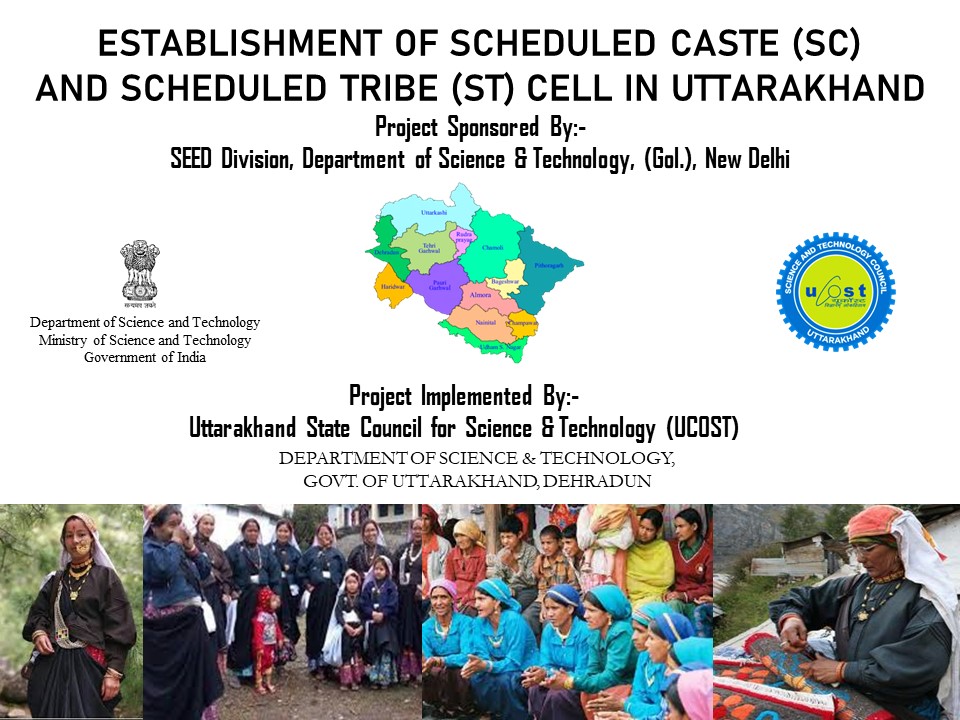SC/ST Cell

Project Title: Establishment of Scheduled Caste (SC)/Scheduled Tribe (ST) Cell in Uttarakhand State Council for Science and Technology (UCOST), Dehradun.
Project Funded by:
Science for Equity Empowerment and Development (SEED) Division, Department of Science & Technology (DST), New Delhi.
Project Co-ordinator’s
Dr. D.P Uniyal, Joint Director, UCOST (Project Co-PI)
Dr. M.S. Rawat, Scientific Officer (Project Co-PI)
Project Team:
Mr. Santosh Rawat, Principal Project Associate
Mr. Sunil Tewari, Principal Project Associate
Mr. Punit Singh, Project Associate
Mr. Gaurav Chamoli, Project Associate
Mr. Paras Upadhayay, Project Assistant
Ms. Urmila Ghildiyal, Project Assistant
Project Overview:
Uttarakhand State Council for Science & Technology (UCOST) is implementing the project entitled “Establishment of SC/ST Cell in Uttarakhand State Counci for Sceince & Technology” funded by Science for Equity Empowerment and Development (SEED) Division, Department of Science and Technology (DST), GOI, New Delhi. This project aim to target the SC/ST community residing in hilly region of Uttarakhand which is having a population size of 18.76 % for Schedule Caste (SC) and 2.89 % Schedule Tribes (ST) of total population in Uttarakhand (As per Census 2011).The project will be implemented with an objective to assess the livelihood system for sustainable livelihood planning through science, know-how & practices, where focus will be on to capture traditional & indigenous knowledge and upgrade the skills, building on local innovation & local knowledge systems, while establishing the database of promising technologies that can be taken up for widespread adaption and mapping the same on spatial domain. Under this project SC/ST cells will be established at all 13 districts of Uttarakhand. These cells will act as a coordination cell to promote adaption of appropriate and relevant technologies for socioeconomic development of target population, and to promote, replicate and scale up the successful technologies leading to socioeconomic empowerment and capacity building with further, development of programs and projects for strengthening human capacities, Institutional capacities and technology deployment.
Objectives:
- To assess the livelihood system for sustainable livelihood planning through science, know -how and practices.
- To capture traditional and indigenous knowledge and upgrade the skill, building on local innovation and local knowledge system.
- Establishment of database of promising technologies that can be taken up for widespread adaption.
- Mapping of the above data and resources of spatial domain.
Methodology
To ensure timely deliverables of the proposed objectives the methodology to be adopted is as per the site specific priority areas varying from geographical area of Uttarakhand, and work undertaken on the basis of need-based knowledge for the socio-economic upliftment of the community with adaptation of Food Preservation Unit (Horticulture & agriculture Products), Artesian & Handicrafts Unit, and Scientific gazettes preparation unit including indigenous/traditional knowledge testing unit with product quality validation and market linkage and Mapping through Remote Sensing (RS) & Geographical Information System(GIS).
Project Deliverables:
In desideratum to identify suitable technology for the improvement of agriculture, horticulture practices/products and strengthening Council’s Technology Recourse Centre (TRC’s) while up keeping the health and hygiene by using modern science based products the project expected to have 5-6 clear cut deliverables
- Human Resource Development of SC/ST Community.
- Establishment of Site based Skill Development Centre.
- Identification of Gaps in Existing Government/Non-Government Schemes.
- Formulation, Strengthening, Coordination & Documentation of programmes/Projects, for filling the gaps through S&T interventions.
The Proposed Model development under the project through S&T intervention in SC/ST area can be replicated.

